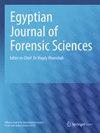Particulate matter in necropsy activities: experience from a health operators’ exposure monitoring campaign
IF 1.3
Q3 MEDICINE, LEGAL
引用次数: 0
Abstract
Operators in the obituary and necropsy sectors are exposed to various environmental hazards during specific tasks. Despite this exposure, occupational risks have often been underestimated, resulting in a lack of substantial evidence. The primary objectives of this study were to identify sources of chemical risk, establish procedures for monitoring and quantifying exposure during necropsy activities, and recommend adjustments to regulatory guidelines to protect the health of the operators. The study was conducted at the Legal Medicine Unit of the Umberto I General Hospital in Rome, focusing on the quantitative measurement of particulate matter (PM) exposure among at-risk operators during necropsy activities. Environmental levels of total suspended particles, PM10, PM4, PM2.5, and PM1 were assessed by evaluating the average, minimum, and maximum instantaneous indoor concentrations using an airborne analyzer. The monitoring activities revealed that the PM concentrations were significantly lower than the recognized reference values. However, bone sawing, body removal, and cleaning were identified as high-risk maneuvers for dust suspension. Our study highlighted specific risks associated with necropsy activities, particularly concerning timing and certain maneuvers. These results may lead to interventions for improving current prevention procedures, implementing good practices, and developing specific guidelines to enhance operator safety.尸体解剖活动中的微粒物质:卫生操作人员暴露监测活动的经验
讣告和尸体解剖部门的操作人员在执行特定任务时会接触到各种环境危害。尽管存在这种接触,但职业风险往往被低估,导致缺乏实质性证据。这项研究的主要目的是确定化学风险的来源,建立监测和量化尸体解剖活动中接触风险的程序,并建议调整监管指南以保护操作人员的健康。这项研究在罗马翁贝托一世综合医院法医部进行,重点是对尸体解剖活动中高危操作人员的颗粒物(PM)暴露进行定量测量。通过使用空气分析仪评估室内瞬时浓度的平均值、最小值和最大值,对总悬浮颗粒物、PM10、PM4、PM2.5 和 PM1 的环境水平进行了评估。监测活动显示,可吸入颗粒物的浓度明显低于公认的参考值。不过,锯骨、移除尸体和清洗被确定为粉尘悬浮的高风险操作。我们的研究强调了与尸体解剖活动相关的特定风险,尤其是在时间安排和某些操作方面。这些结果可能会导致采取干预措施,以改进当前的预防程序、实施良好操作规范和制定具体准则,从而提高操作人员的安全。
本文章由计算机程序翻译,如有差异,请以英文原文为准。
求助全文
约1分钟内获得全文
求助全文
来源期刊

Egyptian journal of forensic sciences
MEDICINE, LEGAL-
CiteScore
2.00
自引率
0.00%
发文量
51
审稿时长
17 weeks
期刊介绍:
Egyptian Journal of Forensic Sciences, the official publication of The International Association of Law and Forensic Sciences (IALFS), is an open access journal that publishes articles in the forensic sciences, pathology and clinical forensic medicine and its related specialities. The journal carries classic reviews, case studies, original research, hypotheses and learning points, offering critical analysis and scientific appraisal.
 求助内容:
求助内容: 应助结果提醒方式:
应助结果提醒方式:


